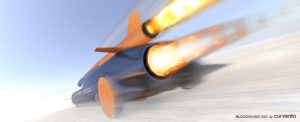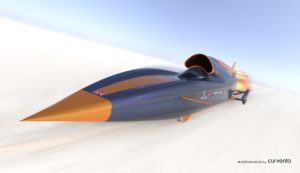It’s not just potential F1 World Champions we’re producing round here these days – it’s also plans for mind-buggeringly fast jet-propelled cars.
Last week saw the announcement that aerodynamicists at the University of Swansea are part of a team aiming to set a new world land speed record of a thousand miles per hour by 2011. Nobody tell Richard Hammond…
That’s 30 per cent faster than a car has ever gone before – and it’s the science of computational fluid dynamics, something that’s increasingly important in designing F1 cars, that will help achieve this.

The Swansea team, funded by the Engineering and Physical Sciences Research Council, has spent the last year creating the predictive airflow data that has shaped the Bloodhound SSC car.
It hopes that, in time, its reseach could lead to better vehicle and aircraft design, improved fuel efficiencies and new medical techniques.
Dr Ben Evans, a researcher on the project, explained: “From the nose to the tail, anything that has any kind of aerodynamic influence, we are modelling.
“It’s the kind of thing aerospace engineers would have traditionally done in a wind tunnel. But we’re doing it on a computer, a big multi-processor super-computer.
“Wind tunnels have massive limitations. Bloodhound SSC is a car, so it’s rolling on the ground and there are no wind tunnels in existence where you can simulate a rolling ground with a car travelling faster than mach one, faster than the speed of sound.”
The team says that this ‘mach factor‘ is the major difference between this vehicle and the current holder of the world landspeed record.
Thrust SSC reached the sound barrier and was supersonic for a few seconds during which it drove the needle up to a world-beating 763 mph.

But the target speed for the new car is 1,000mph, or mach 1.4, which means even higher performance – and going supersonic for longer. The shockwaves this creates will be far stronger than Thrust SSC and will interact with the car and the desert floor for much longer.
Dr Evans continued: “Once you start approaching, and go beyond, the speed of sound you can no longer send a pressure wave forward to tell the air ahead of you you’re coming.
“What happens is a big pressure wall builds up in front of you. Rather than air slowly and smoothly getting out of the way, at supersonic speeds these changes happen very suddenly in a shockwave.”
He said that supersonic aircraft create these shockwaves which dissipate in the surrounding atmosphere but still reach the ground as a ‘sonic boom’.
“What we’re trying to understand is what happens when this shockwave interacts with a solid surface which is a matter of centimetres away. As the car interacts with the desert, and the shockwaves interact with the desert, they actually eat up the desert floor.
“That introduces sand particles into the aerodynamic flow around the car and this interaction is not accounted for in standard CFD work. We plan to look at this spray drag phenomena, what happens and when, and how the sand particles impinge on the car.”
And, just like race car design, the shape of the nose and the generation of downforce are important areas of the project. The Ministry of Defence and the Royal Air Force have also been asked to contribute expertise.
To learn more about the Bloodhound SSC project, visit its pages on the EPSRC website or go to the project website.
This may all sound a bit dry, but it’s not – you can read interviews with the engineers working on the car, learn a little about the research behind it and listen to an audio discussion with Sir Richard Noble who designed the Thrust SSC.
In fact there’s only one item noticeably absent – the crucial reassurance that they’re not planning to let Hammo, or any other member of the Top Gear team, go within 100 miles of the thing…
